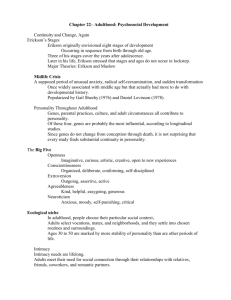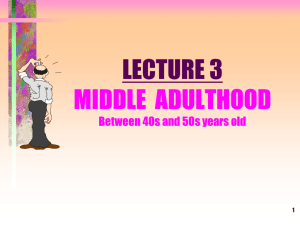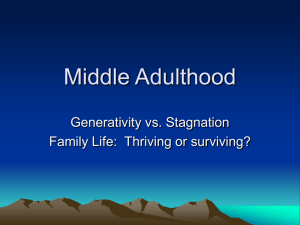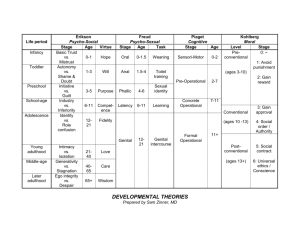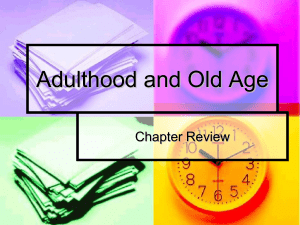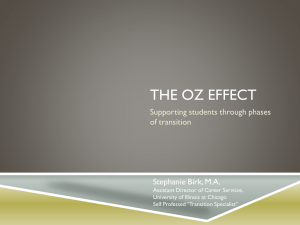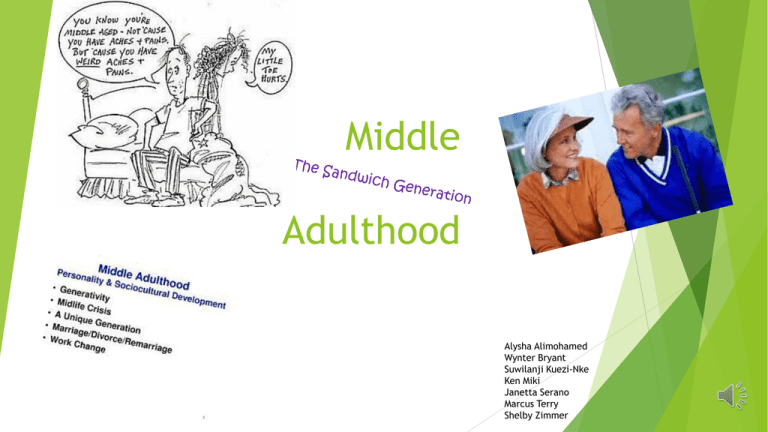
Middle
Adulthood
Alysha Alimohamed
Wynter Bryant
Suwilanji Kuezi-Nke
Ken Miki
Janetta Serano
Marcus Terry
Shelby Zimmer
What is “Middle Adulthood”?
Different views from researchers
When does it begin? Ages 40-64 or 30-70
What is Middle Adulthood?
Central or midlife
Different views from researchers
Either chronological or developmental
Is Middle Adulthood about gains and loses?
Achieving goals
Unmet goals
Psychological changes
Cognitive changes
Biological changes
Social changes
So you want to know the 3 main
theories on Middle Adulthood….
Generativity vs. Stagnation (Erik
Erikson)
Finding Balance (Carl Jung & Daniel
Levinson)
Life-Span theory and the Gain-Loss
Balance
Generativity vs. Stagnation: Erik Erikson
Generativity is the ability to channel personal interests to provide care, concern and
guidance for both younger and older generations while leaving a legacy.
Meaning? They want to feel a sense of purpose – a way to help and guide
younger generations based off of their own interests and strengths.
“Erikson saw generativity as an instinct that works to perpetuate society.”
(Hutchinson, 2011) - paraphrase
Productivity at this stage is measured by their contributions to their family
and society as a whole.
Without finding a way to connect and contribute to future generations, adults
in this age span become self-absorbed and therefore feel stagnant.
http://www.youtube.com/watch?v=XBMOIvBXa68
Challenges to Erikson’s work…
Recent research suggests that people are living longer due to further
education and better healthcare so Erikson’s Generativity vs. Stagnation
theory may apply to older adults.
John Kotre (1995) argues that there are different types of generativity
including: communal generativity, and agentic generativity, and cultural
generativity.
Finding Balance: Carl Jung
Searching for our true self after repressing our identity to conform to
society’s norms
Gender identities and roles diminish
Balance between introversion and extroversion
Introvert: more comfortable with the inner world of thoughts and feelings.
View the world as how it affects them.
Extrovert: more comfortable with the world of objects and other people.
More concerned with their impact in the world.
Finding Balance: Daniel Levinson
Levinson had a part in coining the idea of the mid-life crisis.
As cited in Hutchinson (2011), Levinson asserted that during the transition into
middle adulthood, individuals attempt to give greater attention to previously
neglected components.
Levinson frames this as trying to balance four opposing aspects of identity:
Young vs. old
Creating vs. destruction
Feminine vs. masculine
Attachment vs. separation
Gain-Loss Balance
Evidence of gains in self-esteem and emotional maturity
Losses in biological functioning
These gains and losses are subjective: they are given
meaning and worth based off of cultural context and
values
Gains and losses are shaped by group-based and
individual-based attributes
Biological Changes and Physical and
Mental Health in Middle Adulthood
Despite dramatic increase in numbers of adults in the last few decades, between
the ages of 45-60 some physical and mental decline begins to occur.
Changes="aging process" stem from interactions of biology with the following
factors:
-psychological
-sociocultural
-spiritual
Biggest changes for biology, physical/mental health:
-physical appearance
-changes in mobility
-reproductive system
-beginnings of chronic disease
Wow…you’re turning into a
completely different person!
Changes in Physical
Appearance
Changes in Mobility
Skin: wrinkles, loss of
firmness/elasticity, dryness, spotty
localized pigmentation
By 40s losses in muscle, bones,
joints = mobility loss, by 45 =
strength loss.
Hair: thins/grays on head, appears
in unwanted areas-ears, eyebrow
clumps, facial hair on women.
Max bone density reached early
adulthood, loss of bone material
occurs following max period
Build: loss of height, gains in
weight starting in 40's, half inch
height loss per decade-loss of bone
material in vertebrae
Joints/cartilage- obvious changes
start in 40s
Changes in the Reproductive System
Middle adulthood: women's ability to conceive/bear children
declines until cessation
Menopause: permanent end to menstruation, medically defined as 12
consecutive months. Median age = 50, 51. 90% of U.S women experience
between 45 and 55.
This change is not obvious.
Lowered sperm counts starting in 40s and 50s, testes shrink due reduction in
volume of seminal fluid after age 60.
At this stage both men and women begin to experience decreased sexual
functioning; yet, many couples manage to maintain healthy sex lives.
Feeling a Little Tense?
Maybe it’s Chronic Stress!
Cortisol is known as the ‘stress hormone’ that gets released in stressful situations to
give you a surge of energy to react when you need to (such as moving fast if you’re
about to be hit by a car). However, it becomes unhealthy (and may contribute to
aging, according to the new study) when long-term stress signals the body to keep
releasing cortisol and wears down your body.
BUT WAIT THERE IS HOPE!!!!
The good news is that there are a number of simple lifestyle tricks that can help you
slash your cortisol levels. For example, earlier research found that subjects who
practiced Buddhist meditation significantly decreased both cortisol and blood
pressure in a 6-week Thai study. Similarly, participants who meditated daily for 4
months decreased the hormone by an average of 20% in a study at Maharishi
University, while levels in the non-meditating control group actually went up slightly.
Health is Highly Variable Amongst
Middle-Aged Adults
The
highest death rates are amongst
African-American males.
Fatal
accidents and cold and allergies tend
to decline.
Feeling a little “under the weather”?
Chronic conditions and illness
Persistent Symptoms
Functional disabilities began to arise
Chronic conditions increase with each passing decade from middle
adulthood on. Chronic conditions often lead to the following problems:
Slow process that likely leads to disability before death
Is major cause of death in middle and high income countries
Stress will cause illness to rapidly increase
Dehydroepiandrosterone (DHEA)
Secretory products of Adrenal
Glands
Convertible into androgens and
estrogen
Based on the abundance during the
frequent diseases of aging
Used in the U.S. and other
countries as nutritional supplement
for anti aging & metabolic support
Bringing it All Together
-Mental Health
-Suicide
-Substance Abuse
http://www.huffingtonpost.com/2
013/05/02/suicide-rate-risesmiddle-aged_n_3203936.html
Mental Health: Why Am I Feeling this Way?
Depression is the most common mental health disorder
amongst middle-age adults


